From Fedele

This year, the Farm to Fork program turns 25 years old. Our quest to “save flavor” –as we put it back then – has grown and evolved in ways we couldn’t have anticipated.

From Fedele

This year, the Farm to Fork program turns 25 years old. Our quest to “save flavor” –as we put it back then – has grown and evolved in ways we couldn’t have anticipated.
I CAN’T TELL YOU HOW MUCH IT MEANS TO ME TO BE WRITING THIS NOTE TO YOU. OVER THE YEARS I’VE WRITTEN MANY NOTES TO OUR TEAMS IN THE FIELD, SHARING MY EXCITEMENT ABOUT NEW CAFÉ OPENINGS, MY ZEAL FOR SIMPLE COOKING, MY PRIDE IN THE MAGIC WE CREATE FOR OUR GUESTS EVERY DAY. SINCE WE LAST PUBLISHED BRAVO IN FALL 2020, I’VE MISSED SITTING DOWN AND TALKING TO ALL OF YOU THROUGH THIS LETTER. AND I’M SURE THAT I’M NOT ALONE WHEN I SAY HOW THRILLED I AM THAT BRAVO IS BACK! And, like many things that changed since 2020, Bravo doesn’t look the same as in its last evolution. We’ve changed some things (and kept others the same), but our commitment to celebrating the hard work all of you do in the field, day in and day out, is still at Bravo’s core. Thank you.
By the time you’re holding this issue in your hands, it will be harvest season, and teams all over the country will be ramping up their Eat Local Challenge (ELC for short) activities. The ELC is one of our most cherished annual events, and it sprung out of a desire to highlight our Farm to Fork partners. This year, the Farm to Fork program turns 25 years old. Our quest to “save flavor” — as we put it back then — has grown and evolved in ways we couldn’t have anticipated, with over 1,700 vendors enrolled in our program, a group of “foragers” whose role is to seek out new potential vendors in their communities, and many meaningful, long-term relationships between chefs and our vendors. Our commitment to supporting farms and businesses who are local to our accounts sets us apart from our competition in meaningful ways.
Communications manager (and former Fellow) Peter Todaro writes about the evolution of Farm to Fork in our feature story on page 22. It’s an inspiring read that walks us through how the program has grown up. But like any 25-yearold, Farm to Fork is still evolving, as we highlight in our recently published white paper that looks at some of the intricacies of purchasing and participating in the program. I look forward to seeing how Farm to Fork will continue to inspire our teams for the next 25 years and beyond.
Speaking of inspiration, it’s energizing to see how Bon Appétit has continued to push ourselves to be at the forefront of a plant-forward revolution. The expertise and passion across our company will be one catalyst in ushering in plant-centric eating as the cultural default, helping to reduce the greenhouse gas emissions that are linked to our levels of meat and dairy consumption. Our plant-forward cuisine is beautiful, delicious, and good for both people and the planet — what could be better? You can read all about what teams are cooking up in the feature story on page 44.
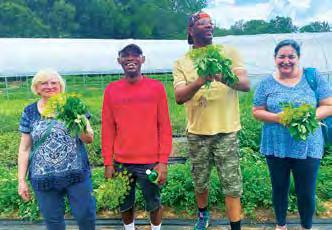
I’m so proud of what we’ve built. As we continue to grow, leaning into our values will be more important than ever. As I wrote for our blog earlier this year, sustainability is everyone’s job in this company. You are all the experts in implementing and living our Dream.
The newest version of Bravo reflects that ethos — we’re turning to you, our experts, to share your knowledge in these pages so that we can all learn from each other. From working to strengthen local food systems, to our efforts to track and reduce food waste, to our brand activations and most importantly — our incredible food, this group of talented people makes me proud and gives me hope for the future every day.
Bravo to all of you!
Love, Fedele
01 FROM FEDELE Dear Bon Appétit Family – Fedele Bauccio
04 COME IN, WE’RE OPEN Sand Hill Sundeck, Pinterest, and More
20 FROM MICHAEL A Letter to Operators – Michael Bauccio
06 FROM THE FIELD Inspiration From Your Fellow Bon Appétiters
12 HOP ON THE TRACKING TRAIN Tips and Tricks for Building Our Food Waste Tracking Movement
14 WHEN BEING UNREASONABLE IS RIGHT How One Book Inspired a Companywide Program
22 25 YEARS OF FARM TO FORK Celebrating Our Groundbreaking Sourcing Program
48 PRODUCE PRINCIPLES Fungi in the Limelight
58 WHAT’S HOT AND WHAT’S NOT In Bon Appétit’s Image & Style World – Carrie Buckley
50 BE KIND TO YOURSELF Transforming Our Wellness Message – Terri Brownlee
16 LASTING CONNECTIONS, ONE (VIRTUAL) CUP AT A TIME Discover Our New Virtual Networking and Mentorship Program
36 PLANT POWER Growing a Revolution
52 STAY SAFE OUT THERE Perspectives From the Field on Building a Great Safety Culture
54 HAVE YOU NUDGED LATELY? Cookbook “Shelfies”
56 RECIPES FOR SOCIAL SUCCESS Three Tips for Engagement
18 THREE PROGRAMS SHAPING THE FUTURE OF LEADERSHIP AT BON APPÉTIT Level Up Your Career
44 PLANTS, BEAUTIFUL PLANTS A Dose of Plant-Forward Inspiration
62 WOMEN IN CULINARY PROFILE Highlighting Two of Our Stars
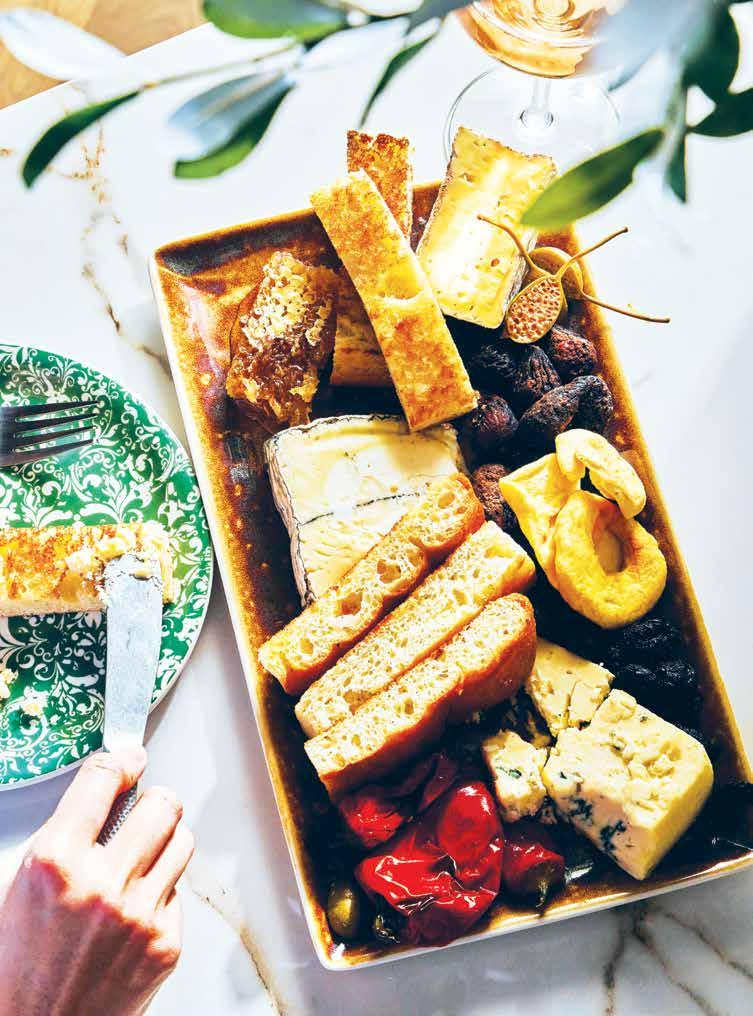
Sand Hill Sundeck was a big opening this past spring, a multi-faceted spot featuring a dine-in area serving house-made pastas and pizzas, sandwiches, and small plates; a New York-style deli and boutique market with distinctly Californian vibes; and of course, a sprawling deck with a firepit and seating area for relaxing and dining alfresco. The Sundeck is a partnership between real estate developers DivcoWest and Bon Appétit.
“What I want to bring to Sandhill Road with the Sundeck is that delicious, exploratory energy of the deli while using the world’s pantry in a really creative way,” says Culinary Director Nicolai Tuban.
In late 2023 we brought on a global financial services company as a national account, opening nine sites across the country into 2024. Across the five cafés and four espresso bar locations, a team of 108 staff members opened 39 stations! Scratch is the most popular station with Spice Route as a close second. Guests have been enjoying the increased menu quality and variety, engaging activations like cooking classes, and the new ability to order online. Says one happy guest, “The change is noticeable — going to the office now feels like I’m going to a friend’s or relative’s place where I know I’ll be well fed!”
Teams also opened Pinterest in late 2023, welcoming eight locations across North America by early 2024, with more on the horizon. Pinterest is on a mission to bring everyone the inspiration to create a life they love — and our teams are proud to feed that mission, whether that’s with top-notch coffee bars, plated-style service in San Francisco, or rebranded digital signage throughout the cafés.
And in case you missed the highlight on our blog, the Butler University team executed a major renovation of the café that formerly occupied Butler’s Residential College (ResCo). It re-opened with a new look and feel, many new amenities and plenty of old favorites, and a new name — Midtown Provisions. From a brand-new pizza oven, to an expanded C-Store, to a mural by a local artist animating the space, the new offering is a fantastic addition to campus.
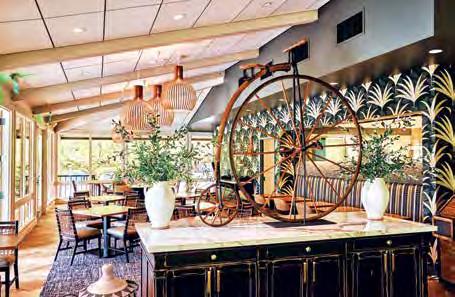

BY LEIGH BELANGER
BY THE TIME YOU’RE READING THIS ISSUE OF BRAVO, TEAMS WILL BE GEARING UP FOR THE EAT LOCAL CHALLENGE AND LOOKING AHEAD TO THE HOLIDAYS. PRINT MAGAZINES ARE GOOFY LIKE THAT. STAGING A THANKSGIVING PHOTO SHOOT IN JULY FOR AN ISSUE THAT WILL HIT IN NOVEMBER? WHY NOT?
SAME DEAL WHEN WE GATHER YOUR STORIES ABOUT THE MANY EVENTS AND ACTIVITIES YOU’RE PULLING OFF, DAY-IN AND DAY-OUT, THROUGHOUT THE CALENDAR YEAR.
WHETHER A THING HAPPENED THIS PAST APRIL OR YESTERDAY, THE AIM IS THE SAME: TO TRANSMIT OUR DREAM AND OUR SENSE OF HOSPITALITY TO OUR GUESTS, EVERY DAY. WITH THAT IN MIND, SETTLE IN FOR SOME INSPIRATION FROM YOUR FELLOW BON APPÉTITERS. BECAUSE YOU ALL HAVE BEEN BUSY.
That sense of fellowship you get when you come together with a group of folks with common interests or goals? It’s the best, and our teams facilitate it in all kinds of unexpected ways. Like a pizza-making competition between the residence halls at Rose-Hulman Institute of Technology — complete with brackets like it was March Madness. The winning pizza had bacon, tater tots, and a ranch drizzle. Sounds like...college!
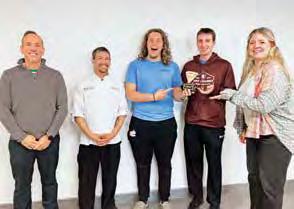
RYAN ROGERS (L), RECRUITMENT AND MARKETING MANAGER, AND MATTHEW LEEPER (SECOND FROM LEFT), EXECUTIVE CHEF, GOT INTO THE SPIRIT WITH ROSE-HULMAN’S PIZZA-MAKING WINNERS!
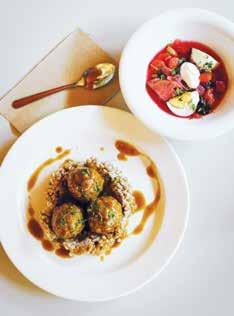
ZRAZY AND BORSCHT FROM THE CLASS OF 2027 FOODS FROM HOME COOKBOOK-INTHE-MAKING AT PENN.
Whether it’s a pizza or a recipe from home, our students like getting in on the cooking action. To wit: a new collaboration between Penn Dining and members of the class of 2027 called Class of 2027 Recipes from Home cookbook. Students can submit nostalgic recipes from home (to date — a fried rice and Chinese sausage, and zrazy [beef roulade] and buckwheat groats dish from Ukraine), the Bon Appétit culinary team at Penn will test, refine, and host a tasting for the students, with the vision to compile the recipes into a cookbook that the Class of 2027 will receive when they graduate.
Speaking of cookbooks, check out what some of our culinarians keep on their bookshelves in the Nudge section of this issue, page 54.
We loved reading about the event at Target HQ to honor the launch of the Smithsonian Women’s History Museum, planned to open on the National Mall in Washington, DC, within the next decade. An all-women lineup of vendors, providing everything from the linens to the black cherry spritzers, was an extrathoughtful touch from the (women-led) catering team.
Chase Center in San Francisco, CA, recently hosted a 650-person dinner in the stadium for the Positive Coaching Alliance, a youth sports non-profit. OMG: it was broadcast on live television, so the team had to orchestrate truly next-level service under a very controlled timeline. They had just over 40 minutes to clear all salad plates from 65 tables with 10 guests per table, top off beverages, and deliver a synchronized serving of entrées to each guest seated at a table. Get it, Team Chase Center!
At the Ford Foundation in New York, Executive Chef Sari Frank has been collaborating with foundation staff on a series of menus catering to the global population at Ford. Sari has captured the authentic flavors and looks of some of the world’s most iconic foods, from hamantaschen cookies for Purim to sancocho and ceviche during Latinx Heritage Month. Our team’s goals at the Ford Foundation are firmly rooted in social justice for all, which reinforces the strong alignment shared between Bon Appétit and the Ford Foundation.
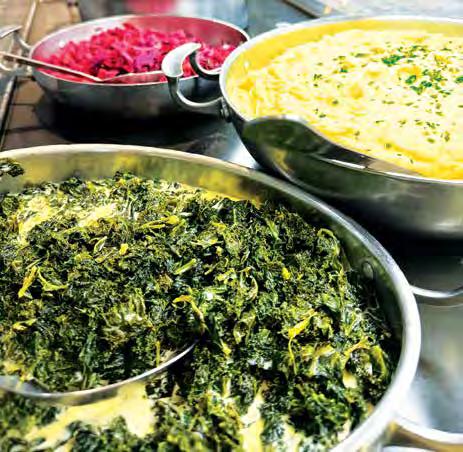
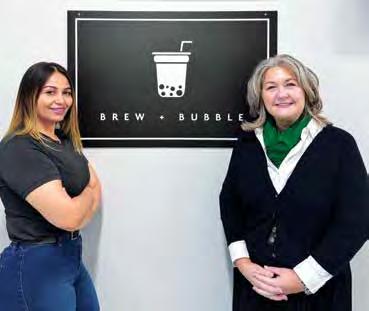
Not one but three different universities submitted their stories of hosting International Nights.
At Trine University in Angola, IN, over 1,000 people attended iNight, the culmination of the university’s Diversity Week, with Canada, Sweden, Korea, Jamaica, and Togo all represented.
Since a large percentage of Trine’s international population hail from the small African country of Togo (and a handful are employed by Bon Appétit), Sous Chef Aliviah Sweeney teamed up with a Togolese student-worker to create gboma dessi, a well-known Togolese dish of stewed beef and spinach. “I not only gained cultural insight, but it was great to connect to a Trine student and Bon Appétit employee over food,” says Aliviah.
At Furman University in Greenville, SC, Chef Gustavo Sanchez Salazar and his team prepared dishes from over 30 countries from scratch including arepas, empanadas, tamales, and croquettas. Using recipes and her past experiences of working in her family restaurant in Cuba, Prep Cook Nadiezka Carvajal (also known as KeKa), and her associates made all the dishes by hand to retain full tastes of home.
At St. Olaf College in Northfield, MN, the culinary team featured Subak Hwachae (Korean watermelon punch), a Moroccan-style chicken and many more dishes from all over the world. They passed out bento boxes for late night revelers to enjoy, as well.
Those bento boxes could meet their perfect match over in Berrien Springs, MI, at Andrews University, where a new boba station opened recently, much to the delight of students and visitors to the campus. It aligns with Andrews’ caffeine-free principles while offering a range of flavors and even a proteinforward boba drink. We talked to General Manager Michelle Michalenko about plant-forward efforts on Andrews’ vegetarian campus for our Plant Power feature on page 36.
From rolling out the updated Waste Not™ guidelines to working closely with over 1,700 Farm to Fork vendors, our teams are busy walking the talk.
This school year, high hopes we’ll see the return of Fellow-led tie-dye workshops using food scraps. The workshops get students thinking about the many approaches to minimizing food waste while drawing parallels between the food industry and the fashion industry – two resource-intensive industries with large carbon footprints.
While tote bags and t-shirts soak in dye pots, the Fellows chat with students about climate and sustainability and the ways that food waste impacts climate change. The conversations get the students thinking about how they can reduce food waste in their daily lives.
At Colorado College in Colorado Springs, CO, teams ran with the idea and partnered with the school’s sustainability office, collecting food scraps from the kitchen the day before to prepare the dye pots. “We loved being able to see our kitchen scraps get a ‘second life’ before they went into the compost bin, as food waste is something we’ve really been trying to focus on,” says Cassidy Schnell, community engagement manager.
Let’s not forget efforts to reduce material waste, like the partnership the Chase Center team has forged with Eco Refill Systems, whose refillable cooking oils helped Chase Center keep the equivalent of 2,500 pieces of oil packaging out of the waste stream in the month of February alone.
Earth Day is a big one on the Bon Appétit calendar and a way for teams to flex their sustainability cred.

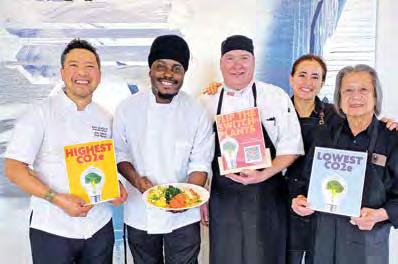
Chefs at KKR rocked our Flip the Switch campaign with 600 plant-based meatballs – people were thrilled; the farmers’ market at University of San Francisco was the stuff Bay Area dreams are made of; a new national financial services’ location in Austin ran with plant-forward meals for the entire month of April (a beet poke bowl was so popular, it made it into the regular grab-and-go rotation). Keep flipping those switches to plants, friends.
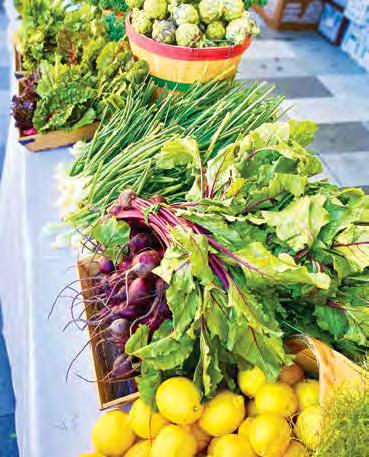
Lots of changes in the Wellness department (see Terri Brownlee’s letter, page 50) these days and LOTS of activity. Pop-ups at Aurora in Mountain View, CA, and Pittsburgh, PA, led guests through our allergen labeling protocol — a safety issue we take quite seriously.
“I didn’t know I loved mushrooms!” said one of the 300 students from schools near STEM Kitchen & Garden in San Francisco who have visited the restaurant for interactive Healthy Kids field trips in the restaurant’s kitchen and gardens. Some kids discover a love for ‘shrooms, others learn that lemons can appear small and green before transforming into a juicy large yellow fruit; that thyme grows in a small bush, producing purple flowers; and yellow and orange nasturtium flowers are edible.
In fact, kids all over the country are building their food literacy in our Healthy Kids programs — from a food–focused scavenger hunt and a gardening activity at Palo Alto Networks in CA to a partnership with the Boys & Girls Club near Le Tourneau University where children from the community made fruit kebabs and vegetable pinwheels. It’s food! It’s fun!
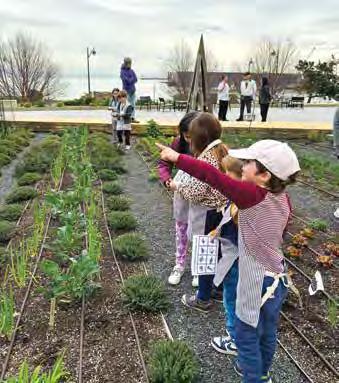

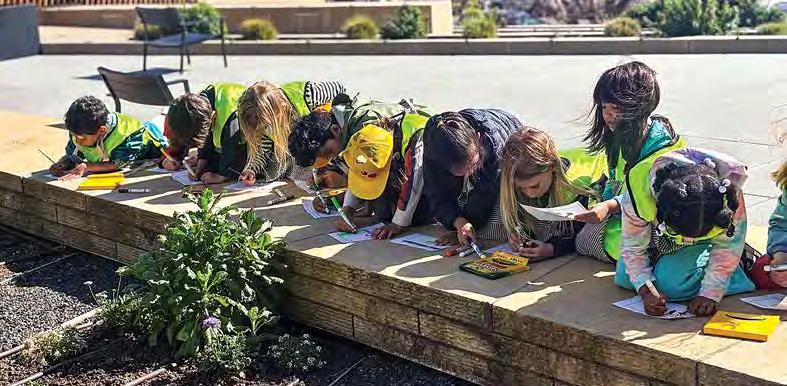
It’s even more fun when there’s competition involved. The Penn Dining team recently hosted their first annual Wellness Cup competition — each residential all-you-care-to-eat café was challenged to create their own version of plant-forward street food.
Penn chefs created not-strictly-vegan dishes such as jackfruit empanadas, hearts of palm lobster rolls, vegan bang-bang cauliflower steak, and cornbread pancakes with seitan chili, spicy maple syrup, and “sour cream” derived from a sunflower seed base. How can we get an invite to this event?!
A panel of judges scored each dish on appearance, taste, texture, creativity, and wellness and sustainability. “It is really impressive to see our diverse team of chefs across campus turn out such creative, flavorful and dynamic dishes for our students,” says campus Director of Culinary Shazad Khan. The winning team has a year to defend their title!

As many of you reading know, we’ve been fighting food waste as a company for decades. And many of you also know that this year, we’re taking waste prevention to the next level by tasking all accounts with tracking food waste.
Tracking waste is one of the most impactful strategies we can implement to reduce waste and our environmental footprint, not to mention its impact on our financial margins.
To help accounts build their waste-tracking muscles, we recently got some advice from teams who have successfully implemented regular use of Waste Not 2.0™ — here’s what they had to say.
New programs need cheerleaders. At the Getty Center and Villa Museum, Executive Pastry Chef Joanne Ponvanit leads the food waste reduction efforts through Waste Not 2.0™. Because she’s been with the company since 2015, her institutional knowledge, consistent presence, and leadership of the program helps keep waste tracking top of mind for the team, says her boss, General Manager Sean Loeffel. Waste Not champions who drive the project and ensure that all staff are welcomed into the program can be integral to its long-term success.
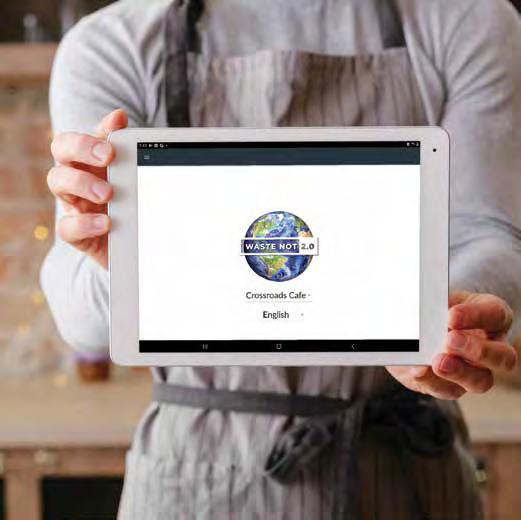
Make it fun!
At St. Olaf College in Northfield, MN, Director of Operations Dylan Johnson likes to create a playful environment in the kitchens around tracking waste. He knows that logging the food you toss into the bin is not the most glamorous part of the job, and it can be hard to keep teams motivated. “If you don’t have fun with it, no one’s going to want to do it,” he says. “But if you build excitement and joke around with people, then you’re changing that culture and that mindset of ‘oh, this is another task I have to do today,’” he says.
Encourage Employee-Generated Solutions
A successful Waste Not 2.0™ program means that all staff feel ownership and are encouraged to find solutions that help incorporate the program into each kitchen’s unique operations. At the Getty, a grill cook noticed how fast his station filled their bin and offered to keep a paper log at the end of the line. From there, one person is assigned to input the data into the tablet. “It’s always important to get employees involved in solutions when you have a program,” says Joanne. “We want them to feel like it’s their program,” says Sean. “They are the ones who will push the impact forward.”

As with any new program, the way it becomes part of every employee’s daily routine is through consistency. “You have to be consistent in creating awareness and driving the commitment for the employees to do the task,” says Sean. Waste tracking is part of their ongoing conversations at “every 10@10, seven days a week,” he says. Chef Joanne has spent two years training, re-training, and reminding team members to stay on top of waste. The outcome is not only literal tons of waste reduced, but they’ve influenced many team members in understanding the environmental benefits of waste reduction, as well as worked with the Getty to pursue a stronger composting program, says Sean.

We’ve long relied on science and data from the Environmental Protection Agency (EPA) to inform our work on food waste prevention and reduction. Last fall, the EPA introduced their updated Wasted Food Scale (image above) — which evolved out of their Food Recovery Hierarchy. The scale prioritizes food waste prevention through carefully managing what is bought, prepared, and served, while doing everything possible to avoid food ending up in the landfill, down the drain, or off to incineration. It reflects the latest science, technology, and operational expertise for food waste management pathways. You can learn more about the Wasted Food Scale at epa.gov/sustainable-management-food/wasted-food-scale.
Teams at the Getty and St. Olaf both use data from Waste Not 2.0™ to motivate staff and create opportunities to workshop waste reduction strategies together. At St. Olaf, pulling data helps motivate managers to think creatively about how to change workflows to prevent waste in the first place, says Dylan.
And at the Getty, visuals from the Waste Not dashboard help to illuminate the volume of what gets wasted, such as showing “a visual for the employees that all the waste that we’ve been producing could fill an Olympic-size swimming pool,” says Sean. Using the metrics from the Waste Not dashboard helps underscore the impact we can have when we reduce waste.
Ultimately, the big-picture commitment to preventing and cutting down on food waste is what keeps these teams on task. So don’t be daunted! “It’s the right thing to do, it’s what we should be doing, stay on top of it and the data collects itself,” says Sean.
BY JENNY SLAFKOSKY
Success can mean many things in the food and hospitality industry — having the “right” number of stars and the most effusive reviews on Yelp, sporting the trendiest décor, or cooking up the most Instagrammable menu items. But at its core, hospitality is about people and their experiences. “The human desire to be taken care of never goes away,” writes Will Guidara, restaurateur and author of the book Unreasonable Hospitality: The Remarkable Power of Giving People More Than They Expect.
As hospitality professionals, we have daily opportunities to impact a guest’s experience by demonstrating care in unexpected ways. Guidara’s idea of unreasonable hospitality — creatively and intentionally developing relationships with people and exceeding their expectations — is the inspiration for Benvenuti, Bon Appétit’s new self-guided hospitality training program.
“When I finished Will’s book, what stuck with me is that what we do each day is all about relationships, and it’s about how we make people feel,” says Carrie Buckley, vice president of Image & Style who created Benvenuti with Paula Nielsen, director of creative services. “Our people and our shared commitment to hospitality are just as foundational to who we are as our sustainability initiatives. With Benvenuti we’re really focusing on our people and the whole idea of what hospitality means to them.”

All participants get a custom Benvenuti journal organized like a daily planner to feel timely and functional for busy operators. The journal includes thoughtful weekly prompts that encourage participants to define what hospitality means to them and then reflect throughout the week on how they can package up that sensibility and deliver it to our guests.
Journaling might not seem to fit into an operator’s busy life, but the tangible quality of the journal encourages each person to take time to pause and reflect — even if it’s just for a couple of minutes a day.
For Soyoung Jeong, sous chef at KKR, the Benvenuti journal has been both inspiring and grounding. “I love it, I’m using it every day,” she says. An avid organizer, the calendar-like format is helpful to keep her thoughts in order while reflecting on how to incorporate hospitality into her daily actions.
“Every single day I have notes because I’ve been thinking about it: Who I appreciate, who is helping me. I keep that small stuff in my notes, and then I look back on it.” Reflecting on these elements helps her understand how the small seven-person team at KKR is functioning and gives her fodder to discuss with Chef Manager Arwi Odense.
“At the end of the day, the team experience affects our guest experience,” says Arwi. “We have to be respectful of each other first.” For Arwi, having something tangible and physical for his team to interact with is an important part of Benvenuti. It encourages a type of engagement and reflection that can be hard to convey at a 10@10 meeting. He also wanted something fun, a way to get his team to connect on a personal level as well as around a shared purpose. Benvenuti fit the bill.
While the KKR team is finding depth and opportunities to redefine hospitality for a small team, in the Southeast/Midwest, teams are embracing it as a region. Groups from different teams have been regularly meeting book club-style to talk through the prompts, says Robert Kasnekaw, regional project manager.
“We’re in our second round of book club with 12 to 14 people, and it really is amazing how it’s not cookie cutter from the first round to the second round,” he says. “I think that really has a lot to say about people’s unique experiences within the industry.” In Robert’s group, seasoned hospitality professionals are getting just as much out of Benvenuti as the employees in their first jobs in the industry. “Everybody’s journey is different, but our destination is the same in the spirit of hospitality,” he says.
Carrie Buckley agrees. She recently had the opportunity to speak to Will Guidara personally (a gift from one of her team members!). During their conversation, he asked how he could be of service to her. The sense of care and kind attention that he imparted with that question felt revolutionary — particularly in a time when caring for others can seem like an afterthought. She knows every Bon Appétiter can replicate that sense of being cared for, whether for guests or one another.
“I think hospitality starts internally,” she says. “We wouldn’t be in food service if we weren’t hospitable people. This industry draws a certain type of person into it, and we all need to remember that part of ourselves. We want to please one another, and we want to create environments where people feel heard.”
Win ‘em Over With Service (WOWS) is an action-oriented hospitality training program featuring interactive group activities designed to reinforce a culture that supports both our teams’ and our guests’ well-being and happiness.
Benvenuti (the Italian word for “Welcome”) is a self-guided hospitality learning program inspired by Will Guidara’s book Unreasonable Hospitality. Benvenuti is designed to help individuals create a personal connection to the concept of hospitality and reflect on how to bring that to guests with their colleagues.
Together, WOWS and Benvenuti offer teamoriented and self-reflective perspectives on hospitality, creating a holistic culture of care for Bon Appétit.
hile job training is essential for being successful in a role, building a career takes more than coursework or on-the-job learning — it takes connections, deep ones. For many, a trusted mentor is a critical resource for building a career with longevity.
But intentionally fostering meaningful connections among hundreds of people at locations distributed across the country requires some serious infrastructure. That’s where Bon Appétit Connects comes in, the companywide mentorship program launched this year in collaboration with the Bon Appétit Diversity and Inclusion Action Council (DIAC) and facilitated by partner Ten Thousand Coffees (10KC). Amy Tomes, General Manager at Macalester College and member of the DIAC, serves as the Bon Appétit Connects program manager.
“My experience with a mentor made such an impact on me in terms of my growth, my dedication to and passion for Bon Appétit,” says Amy, speaking fondly of her longtime mentor, Operations Manager Kent Buell. When the DIAC raised the idea of creating a companywide mentorship program in response to a staff survey showing that employees were hungry for mentorship connections, Amy was eager to help find a solution.
Through the 10KC virtual platform, salaried Bon Appétiters with a variety of job experiences are paired as mentors and mentees based on their interests and characteristics. Each pair meets monthly for a virtual cup of coffee for six months. Prompts and short readings or videos are provided to get the conversation flowing at each meeting. After six months, participants are encouraged to repeat the program either as a mentor or mentee with a new pairing.
As Bon Appétit continues to grow, Amy thinks the program can help people share their knowledge, best practices, and stories with others across the nation. “I’ve never had an experience where I didn’t get a lot out of meeting other people in the organization,” she says.
Ally Padrick, a proposal writer on the corporate team and former general manager, signed up to be a mentor in the first Bon Appétit Connects cohort.
“I’ve always been really fortunate to have leaders who have fostered my own learning,” she says. “At the same time, I don’t know that I’ve ever felt I’ve had a true mentor. So, I thought it would be really helpful and empowering for me to be able to fulfill that for somebody else.”
Ally was paired with Adi Gayosso, an operations manager at Oracle. The two immediately found common ground and reciprocity in their connection. They’d worked in similar operations and even knew some of the same clients and colleagues. But they each had something to learn from each other.
“What I like with my pairing with Ally is she understands my background, and I get to see how she went into a completely different role,” says Adi.
Learning how Ally has grown within the company and has taken a path Adi had never considered before was eye-opening. “You see that the company is more than just food management, like what we do on the floor,” she says.
“There are so many other people in the background that do so many other things. Right now you’re doing this, but maybe your passion is something else and it’s something that you can still do within the company. You just haven’t realized that as it’s not right in front of you.”
For Ally, the experience has been equally rewarding. “I still look at things and think ‘Oh boy, I can still learn from this’ or, ‘I should bring this to my manager.’ It’s really tapped into my own personal desire to keep learning.”
While Ally felt a little bit of impostor syndrome when she signed up to be a mentor, she’s been pleasantly surprised to realize how much wisdom she has to share. “It’s really highlighted the value I do bring to the table and how I can instill that in others.”
Both Ally and Adi agree that the monthly time commitment is manageable, particularly in light of the reward of the connection. Sign-ups for the next Bon Appétit Connects cohort end at the beginning of October. Watch News from Home for details.

HERE AT BON APPÉTIT, WE’RE FORTUNATE TO BE SURROUNDED BY TALENTED PEOPLE EVERY DAY: BARISTAS WHO WIELD A MEAN CAPPUCCINO AND A KNACK FOR EVENT PLANNING; COOKS WHO PREPARE DELICIOUS MEALS AT SCALE AND INSPIRE THEIR PEERS; CASHIERS WHO CONSISTENTLY BRIGHTEN OUR GUESTS’ DAYS.

Maybe YOU have a mind for numbers or a penchant for eye-catching merchandising. As busy operators, many of us wish we could devote more time to strengthening our skills and growing our careers at Bon Appétit.
Denise Massey, manager of Bon Appétit’s leadership and development team, is passionate about establishing, enriching, and expanding our employees’ leadership capacity. She is the developer of three programs shaping the future of leadership at Bon Appétit and, along with Learning and Development Specialist Beth Cooper, teaches courses to Bon Appétiters across the nation.
“In the Leadership Certification Training program for hourly team members, we plant seeds and establish strong leadership roots,” says Denise. “The Essential Management Skills Training program builds on those roots and helps team members blossom into successful managers. The topics presented in the Recipes For Retention Program offer nourishment to encourage continuous growth of our talented team members.”
For Denise, these programs combine the things that she’s most passionate about: diversity, equity, and inclusion; and teaching and training. “When I can combine these and impact lives, that is so rewarding for me,” she says.
Beth feels the same. “I love working with aspiring leaders, witnessing their growth and passion as they transform into dynamic, effective Bon Appétiters. The energy and enthusiasm they bring makes me a better facilitator and I am privileged to witness their journey.”
Get a snapshot of these programs through the eyes of three Bon Appétiters on the following page and read about their full experiences on our blog by scanning the QR code on the left. Want to strengthen your skills? Talk to your manager about which program is right for you.

The
class
is kind of sneaky in ways that you don’t realize what it’s going to open your eyes and mind to.

The
class offered a lot more ways to prepare myself to successfully train and assemble a team.

I wanted to really just expand my knowledge of ways to connect with my team.
– Ryan O’Rourke – Kathryn Davis – Julie Alexander
Establishing Strong Leadership Roots: Strengthens employees’ leadership skills to prepare them for supervisory or managerial roles.
“The class is kind of sneaky in ways that you don’t realize what it’s going to open your eyes and mind to,” laughs Kathryn Davis, General Manager, Fribley Commons at Case Western Reserve University, Cleveland, OH. She recommends the program wholeheartedly to her peers. “I am grateful to Bon Appétit and the wonderful people that have strengthened me as a manager, and you will be too.”
Fun fact: More than 250 Bon Appétiters have graduated from the LCT program since the program debuted companywide two years ago. Many graduates have moved up into positions with more responsibility. The Learning & Development team accepts applications throughout the year and slots applicants into future cohorts based on their availability.
Kathryn’s advice:
Be open-minded. Look at yourself as much as you’re asked to look at other people throughout the process.
Take notes! You can’t remember it all, but it’s important information that you need to have to be effective at your job. Do your homework on time. They’re serious about that!
Enriching Our Managerial Roots: Strengthens managers’ leadership skills so they can be more effective in their roles and continue to grow their careers at Bon Appétit.
“The class offered a lot more ways to prepare myself to successfully train and assemble a team that is well-informed, and how to work better as a team,” says Ryan O’Rourke, Café Manager, Macalester College, Saint Paul, MN. While the course is a time commitment, Ryan says it’s worth the effort. “No matter what you think you know, taking this course will without a doubt open your mind to some new approaches. Kind of a fresh set of eyes on the things you’ve been doing.”
Fun fact: EMS is a new program and Ryan is its first valedictorian! Want to be a future valedictorian? The program is currently working with its second cohort; nominations for the next session open September 30.
Ryan’s advice:
Commit. Don’t let excuses like time constraints get in your way. Head straight into the course and do the best you can.
Communicate. If you’re struggling with timing because you’re busy, communicate with your instructor. They will work with you. Nerves are normal. If you haven’t been in school for a long time, it’s easy to feel nervous. But the people in the group made the experience comforting and easy.
Expanding Our Managerial Roots: Strengthens managers’ skills and offers them tools and resources to be more effective in their roles and continue to grow their careers at Bon Appétit.
“I wanted to really just expand my knowledge of ways to connect with my team,” says Julie Alexander, Executive Sous Chef, Butler University, Indianapolis, IN, about her initial interest in the program. One of the first sessions Julie attended offered a bright idea for getting her team more involved in understanding both expectations and the purpose behind their work. She gathered them to review Bon Appétit’s Dream statement and then challenged them to collaborate on their own team mission statement together. “It was fantastic, everyone contributed,” she says. “We sat there, and everyone gave their own input. It [the mission statement] was built by every single person there, so that was an accomplishment.”
Fun fact: The Learning & Development team offers customized sessions for different regions upon request. They are also always open to suggestions about new topics!
Julie’s advice:
Just. Do. It. You won’t regret it, there will be so much to add to your toolbox. Send a Friend! If you can’t find the time, have one of your supervisors attend. (Limited to salaried employees.)
Share your wisdom. Bring what you learned to your team in meetings. If there are questions you can’t answer, instructors Denise and Beth are always willing to help.

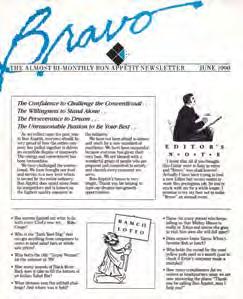

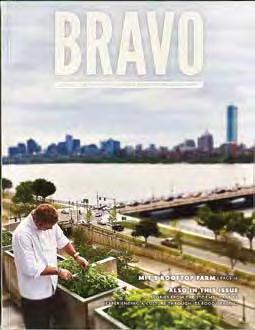
we finish up a terrific fiscal year, pleased I can reach out to you through Bravo again. Our Bravo publication has been an integral part of our family’s connection. Seeing pictures of our people special accomplishments, stories about with our clients and internal updates allowed us an exceptional connection to all parts of our business.
AMichael Bauccio

S WE FINISH UP A TERRIFIC FISCAL YEAR, I’M PLEASED I CAN REACH OUT TO YOU THROUGH BRAVO AGAIN. OUR BRAVO PUBLICATION HAS ALWAYS BEEN AN INTEGRAL PART OF OUR FAMILY’S CONNECTION. SEEING PICTURES OF OUR PEOPLE AND THEIR SPECIAL ACCOMPLISHMENTS, STORIES ABOUT WORKING WITH OUR CLIENTS, AND INTERNAL UPDATES HAVE ALLOWED US AN EXCEPTIONAL CONNECTION TO ALL PARTS OF OUR BUSINESS.
Bravo was launched way back in 1988 and has been an important part of celebrating our people, clients, and successes. It has been a mainstay of Bon Appétit culture. Today, resurrected after the pandemic, we are able to continue our tradition of recognition and sharing.
While much has changed in the world over the past few years, the strength of our company, the strength of our brand, is carried forward by the actions and dedication of every single one of you, every member of our Bon Appétit family. Along with our robust sustainability platform and our concentration on hospitality excellence, our pledge to innovation and flexibility allows us to keep our company vibrant, exciting and sought after.
And even with all the changes that have happened, our core values, commitments to our customers, and to each other, have only grown stronger. To those of you that have been with us for many, many years keeping our promises; and to the newcomers just joining our family; I want to thank each and every one of you for your dedication, hard work, and an everyday attitude of ‘above and beyond’ in all you do.
This makes Bon Appétit the truly special company it is.
Congratulations on an incredible year — I know there are only bigger and better things to come.
Warm Wishes, Michael


IT WAS THE LATE 1990S. GOOGLE WAS A STARTUP, FINE DINING WAS AWASH IN FOAM, AND AI WASN’T A THING. NEITHER WAS THE SUSTAINABLE FOOD MOVEMENT, OR AT LEAST, NOT AS WE KNOW IT TODAY. BUT A PIVOTAL SHIFT WAS COMING, LED BY A COALITION OF ADVOCATES WITH ECOLOGICAL, SOCIAL, AND ECONOMIC CONCERNS ABOUT THE INDUSTRIALIZATION OF OUR FOOD SYSTEM.
BY PETER TODARO

Among them? Bon Appétit Management Company’s chefs and leaders, whose pursuit of flavor was becoming a crisis of flavor. Alongside CEO Fedele Bauccio and company leadership, Bon Appétit’s chefs and managers created Farm to Fork, our groundbreaking sourcing program born out of the resolve to serve our guests the most flavorful food we could get our hands on. “Serving food that was authentic, fresh, and cooked by great chefs was how I wanted to disrupt this industry,” says Fedele.
The sweet, juicy, sun-ripened summer fruits Fedele and others had grown up on had been slowly replaced over the years by their hard and mealy counterparts — we see you, Red not-Delicious apple — bred to look shiny and ripe in grocery displays after traveling long distances. As a company focused on disrupting the soggy steam table paradigm of corporate cafeterias, this was objectionable. Fresh food, alive with flavor, was meant to be our starting point, so we set out to find it.
And find it we did — on local farms near the cafés we operated. “Our chefs really stepped up to work with the local farmers and communities,” says Fedele. “We gave them a roadmap, but they were the ones that really drove the program to its success.” Still, capturing local flavor was harder than it sounds. But the pursuit accelerated Bon Appétit’s development as the standard-bearer for corporate sustainability in the food industry.
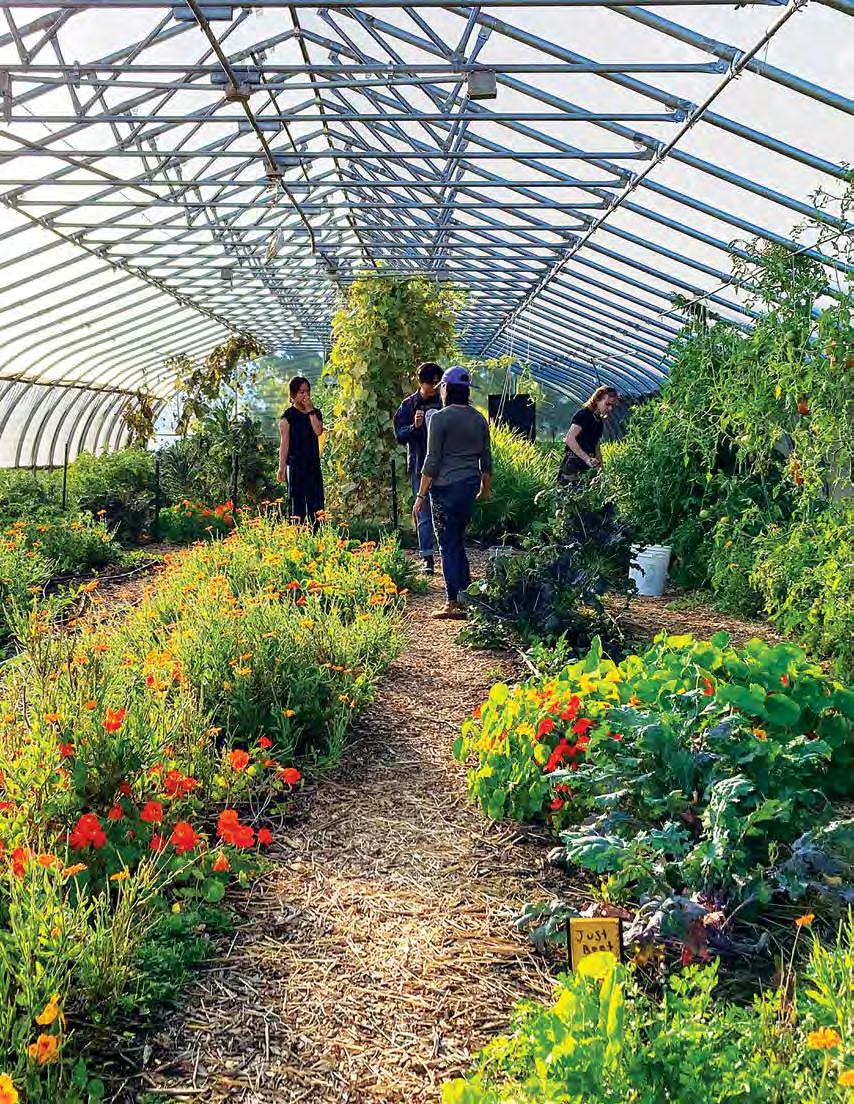

THE SEEDS OF OUR DREAM
For Fedele, sourcing local food spoke to the core of the Bon Appétit Dream. Changing how we purchased food had the potential to transform an industry. So, he went for it. To put clear operational guidelines in place, Fedele and Bon Appétit leadership listened to our teams across the country share what was important to them about sourcing. Again and again, they heard from operators excited by the ability to purchase beautiful, seasonal, delicious food, and by the opportunity to build relationships with farmers and the communities where they worked.
Everyone recognized the importance of purchasing from farms that truly embodied the ethos of small and local, so Bon Appétit leaders outlined a series of parameters for a new companywide local sourcing commitment. Chefs would purchase 20% of their ingredients from farms that were small (under five million dollars in annual revenue), owner-operated, and local in the true sense of the word (within 150 miles of a particular café). Fedele’s guidance to chefs at the time: “Don’t look at an order sheet, go to the farmers’ market!”
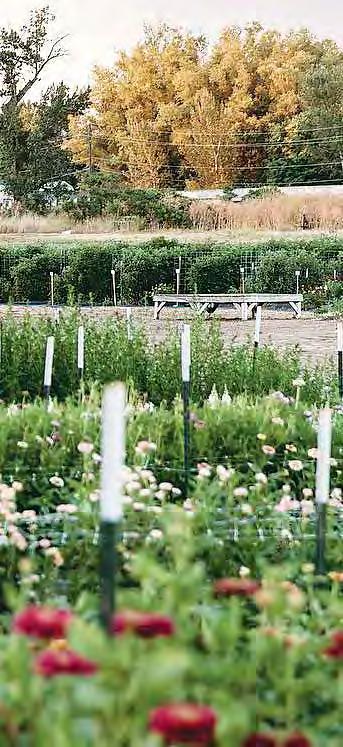
Teams ran with the new program, building enduring relationships with vendors along the way. “I still receive birthday and holiday cards from Vegetable Basket — the first vendor we signed up at Case Western Reserve University,” says Randy De Mers, regional vice president. “The business has now been passed to the original farmer’s son and daughter-in-law, and we still purchase potatoes from them to this day!”
In 2005, inspired by the burgeoning local food movement, we held our first ever Eat Local Challenge — a beloved annual event where Bon Appétiters across the country prepare meals from 100% locally sourced ingredients. This year, we’ll host our 20th Eat Local Challenge, once again bringing guests into closer contact with their local food system and challenging our chefs to think intentionally about putting local flavor on their menus.
Early on, Bon Appétit leaders recognized that relationships were critical to Farm to Fork’s success. They committed to enrolling 1,000 Farm to Fork vendors by 2010 and simultaneously launched the Foragers program, appointing chefs throughout the country, who were (and still are!) tasked with enrolling and building relationships with small-scale farmers and food producers in their regions. “It’s important to shake the hand,” says Vincent Gaikens, a chef and forager at Case Western. “I want the farmer to know they’re a part of our community.”
As the company grew along with the number of enrolled vendors, program leaders looked for ways to expand and diversify the types of producers with shared values to join the program. The Midsize Humane category was added in 2011 to support operations such as midsize poultry and hog farms, cattle ranches, and dairies that meet a stringent set of criteria, including third-party animal welfare certification (by either Animal Welfare Approved, Food Alliance, Humane Farm Animal Care, or Global Animal Partnership). It also helped meet our growing company’s demand for ethically raised animal protein.
That year also saw the development of Fish to Fork — outlining what “local” and “small-scale” mean for both wild and farmed seafood while elevating flavorful and abundant under-utilized species. We added artisanal products in 2014 through a new category called Locally Crafted, highlighting items made in traditional ways or businesses with a focus on uplifting their communities.
In the early days, chefs and managers often paid cash for produce and received paper receipts at the farmers’ market, says Theresa Chester, vice president of purchasing. “To see how the program has grown and how we’ve structured it for integrity is just astounding,” she says, describing spending weekends at the farmers’ market when she was in operations in the early 2000s. “You’d go to the farmers’ market, and whatever was there formed the basis of your menus that week.”
When Farm to Fork was born in 1999, it made Bon Appétit the first food service company to formalize a commitment to local sourcing, while setting the stage for decades of sustainability leadership.
All these developments further embedded Bon Appétit teams in their communities, as our institutional purchasing power has been a source of support for many enrolled vendors over the years. “The enrollment process is the pathway to success in the program,” explains Theresa Chester, “because it creates a network of knowledge between accounts. When all accounts in a region are using the same vendors, it can really help the farmers grow.”
And the vendor mix has allowed teams to diversify their Farm to Fork spend, as we learned from our recently published white paper (see QR code on page 30 for the link). For instance, regions with a shorter growing season might work with more baked goods or coffee vendors to fill the gap in the leaner months for produce.
Throughout the program’s development, Bon Appétit always strove to ensure Farm to Fork remained true to its early goals: focusing on flavorful ingredients and the producers who grew, made, or harvested them, and supporting local food systems from the ground up.
POINT REYES FARMSTEAD CHEESE COMPANY

farm and
a

is
A & J ORCHARDS

Pacific Northwest teams showcase 20 years of collaboration with A&J Orchards, a generational family farm.
Farm to Fork has yielded long-term partnerships with farmers, artisans, and food hubs across the country. Read more about just a few of our nationwide partnerships by scanning the QR codes.

Wagon Coffee
is a women-owned coffee
focused on employing and empowering women in recovery.
CAMPUS FARMS

Teams at Carleton College and St. Olaf College celebrate their campus farms, which are living laboratories for education and sustainability.

A long-term Bon Appétit partnership that feels like family.
RED’S BEST

This dockside Fish to Fork vendor aggregates local and sustainable seafood from over 1,000 fishermen in New England.

MARKET
With roots in Philadelphia, Common Market has grown alongside Bon Appétit to a network of regional food hubs in Atlanta, Houston, and Chicago.

Bon Appétit and Emory University show how values-driven purchasing can help a small farmer scale into new categories.

At its quarter-century mark, the Farm to Fork program is core to Bon Appétit’s identity. Now with over 1,700 enrolled vendors and counting, it’s helped support the local food movement, attracted talent to the company, and been an inspiration for countless other businesses. As we look ahead to the next 25 years, we’re confident in Farm to Fork’s foundational role in our company as local and regional food systems become increasingly important.
Increasing supplier diversity is a current focus. “We’ve been looking at our BIPOC-, women-, and LGBTQIA-owned vendors and seeing how we can better support them,” says Shira Kaufman, a Farm to Fork specialist on Bon Appétit’s purchasing team.
And the successful decentralized model of empowering teams to recruit potential vendors in their regions extends to diverse suppliers. “We’ve had a lot of emphasis on diverse suppliers on the unit level,” says Shira, telling the story of a BIPOC-owned coffee company that will soon finalize its enrollment and become a preferred vendor in a longstanding education account. “I’m seeing more of that story unfold.”
It’s a story we’re grateful to be part of. “Embracing our local farmers and artisans is more important than ever before,” says Fedele. “They’re critical to the future and are deeply important to our chefs and the communities we serve.”

“Sowing Success: Local Food Purchasing Insights from 25 Years of the Farm to Fork Program” gathers key takeaways from 25 years of Bon Appétit Management Company’s experience sourcing local food from small farmers, ranchers, and food artisans. From chef engagement to diversified spend, we share insight into the building blocks of a successful Farm to Fork program. Use the QR code to access the white paper and learn more.


EMBRACING OUR LOCAL FARMERS AND ARTISANS IS MORE IMPORTANT THAN EVER BEFORE.
EMBRACING OUR LOCAL FARMERS AND ARTISANS IS MORE IMPORTANT THAN EVER BEFORE.

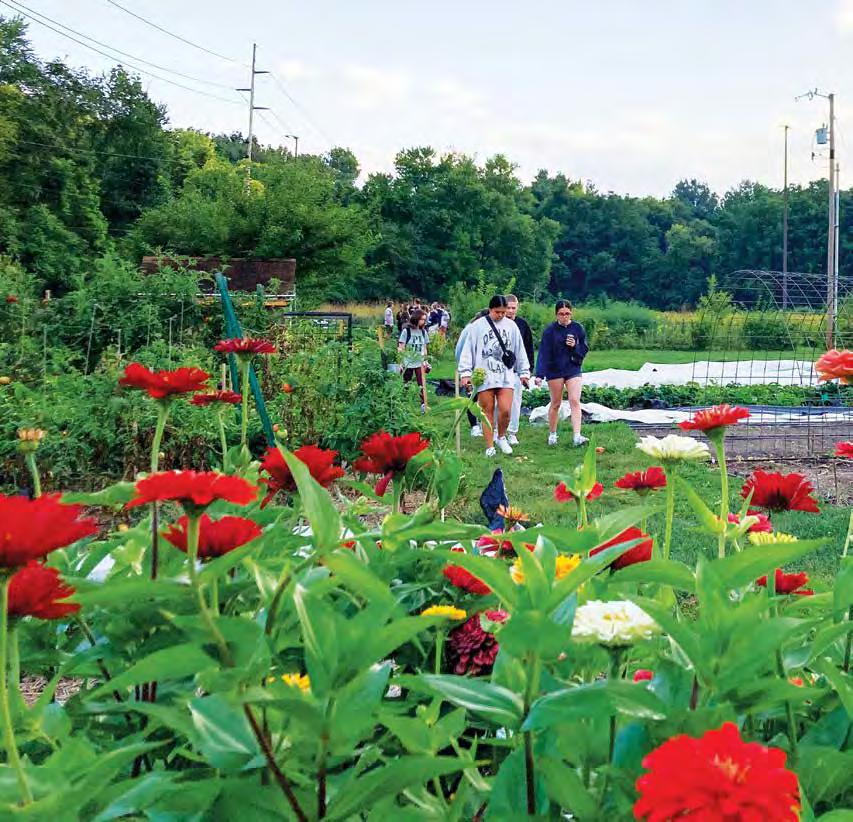
BON APPÉTIT HAS BEEN SERVING CORNELL COLLEGE IN MOUNT VERNON, IA, SINCE 2012. WHEN CURRENT GENERAL MANAGER DAVID SMIGO ARRIVED ON CAMPUS AS THE EXECUTIVE CHEF IN 2016, THEIR FARM TO FORK PROGRAM WAS ALREADY OFF TO A GOOD START, WITH A HANDFUL OF STEADY FARM RELATIONSHIPS. BUT THEIR SCORE WAS LOW AT 8%, SO SMIGO SET OUT TO RAISE IT. IT TOOK ABOUT A YEAR FOR SMIGO AND TEAM TO BOOST THE ACCOUNT’S OVERALL F2F SPEND, WHICH NOW RUNS AS HIGH AS 30%, DEPENDING ON THE SEASON AND WHAT FARMS CAN PROVIDE. HERE’S HOW HE AND HIS TEAM GET IT DONE: 1 3 2 4 5
THEY’RE SYSTEMATIC: A careful audit of F2F purchasing when he started allowed Smigo’s team to make smart decisions going forward. For one, “we looked for opportunities to be more consistent,” he says. For example, Smigo grew his F2F meat purchases by increasing and consolidating his spend with Heartland Family Farms in Argyle, IA. This gave Heartland an opportunity for growth and gave Cornell the chance to build additional relationships with livestock processors to get “products that fit the bill,” he says.
THEY FOCUS ON VOLUME: “You can’t run a F2F program doing small volumes, because your prices jump,” he says. To work with farms to provide what Cornell needed, Smigo would walk the fields with those farmers, discuss planting plans, and come to an agreement about the volume those farms would produce for Cornell.
THEY’RE EMBEDDED IN THE COMMUNITY: Cornell has become an institutional anchor for many farms in the area, with Smigo serving on a task force to help inform policymaking to boost institutional sales of local food in the state. That role puts him in front of all sorts of potential new vendors, he says, but even more it’s rewarding to see how Cornell’s support has brought tangible benefits to the local food movement in Iowa.
THEY THINK BIG PICTURE: In Iowa, where industrialized farming is everywhere, Smigo says, “we really want small farms to flourish.” Institutional support plays a big role in that. “We’re in this together,” he says. When you build mutually beneficial relationships with players in your local food system, you can accomplish more than you think, he adds.
THEY BELIEVE IN THE DREAM: Above all, says Smigo, “If you believe in our Dream...and all the things that we stand for — if you believe in that, it should be driving what you do.”
WHEN IN DOUBT, START WITH COFFEE.
There is often at least one enrolled F2F coffee vendor in most regions, and this is a great way to move to a F2F supplier.
AGGREGATORS CAN BE A GREAT SOURCE of a wide range of F2F products across GL codes (just make sure the products you buy are F2F-approved, as well).
ALIGN YOUR F2F PURCHASING STRATEGY with the particularities of your region. If you’re a coastal account with plenty of local seafood available, lean into that. A Midwestern account may want to focus their efforts on F2F meat and dairy.
Before enrolling new vendors, SEE WHO IS ALREADY ENROLLED. We have over 1,700 enrolled vendors in our network who are eager to work with us!

DO YOU KNOW WHO YOUR FORAGER IS? Foragers are the regional F2F experts and they’re here to help! Get in touch with the purchasing department to find your forager.
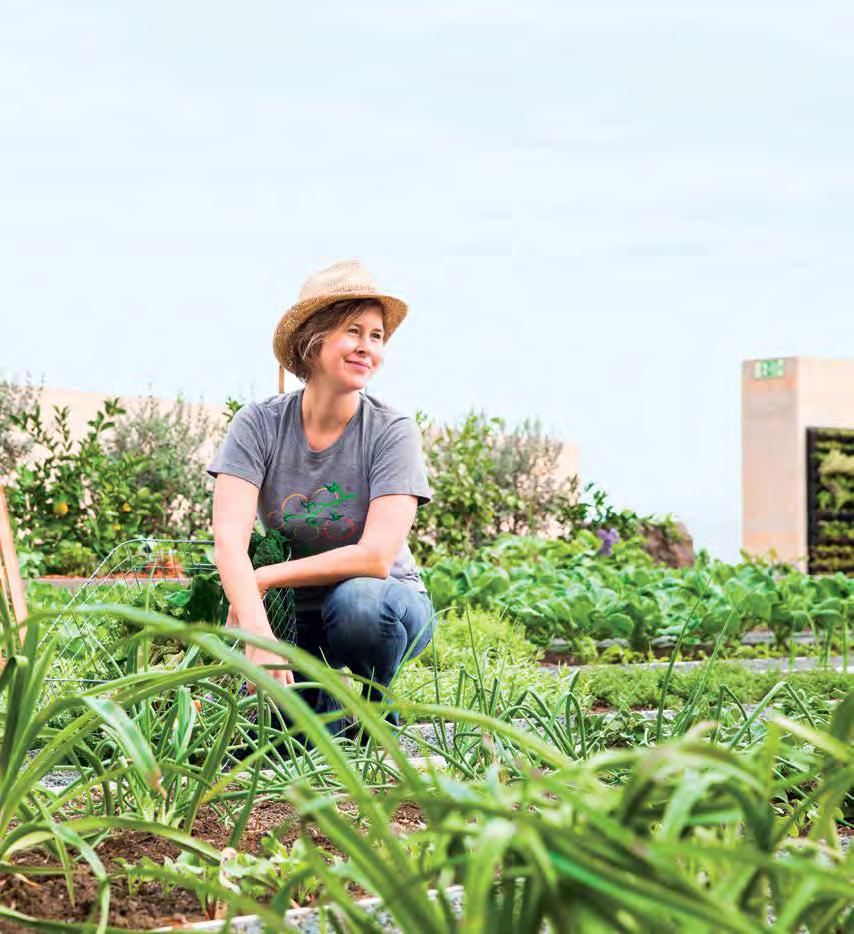


BY LEIGH BELANGER
It’s a question to be asked. Will it Buffalo?
ESPECIALLY AT BON APPÉTIT, AS TEAMS ADAPT THEIR MENUS TO PUT PLANTS CENTER STAGE. “BUFFALO IS A VERB,” SAYS TERRI BROWNLEE, VICE PRESIDENT OF FOOD EDUCATION AND WELLNESS AND ONE OF THE LEADERS OF OUR PLANT-FORWARD REVOLUTION.
Picture it: Brussels sprouts, roasted at high heat so their exteriors char and caramelize while the inside stays almost custardy, tossed with a Buffalo sauce and served with a side of tangy ranch dressing made from aquafaba (the cooking liquid from legumes like chickpeas). Dishes like this are just scratching the surface of the depth of innovation our chefs have been bringing to the table to meet Bon Appétit’s plant-forward goals.
Post-pandemic, we’ve been picking up steam on this effort, most notably in 2022 when we embarked on a series of plant-forward trainings and follow-up programs designed to give chefs the tools and the creative space they need to make the plant-forward magic happen in their kitchens. Eggplant bacon, anyone? When our chefs are fired up, there’s no telling where their creativity will take us as a company. Looking for more plant-forward inspiration? Keep reading to learn how some of our chefs get it done.
To grow a movement, first you need to plant a seed. Our teams need time and space to discover new ways to play with their food — specifically, their vegetables. In a series of plant-forward trainings held throughout the country last year, our culinarians did just that.
Chris Lenza, executive wellness team chef (and plant-forward pro) starts the trainings with a simple premise: Treat your vegetables with the same love, care, and respect you give your animal proteins.
From there, he walks participants through how to apply familiar techniques in new ways. “That’s the geek-out moment for chefs,” says Joe Dougherty, executive chef at the University of Portland. From transforming squash, eggplant, and countless other vegetables into house-made, plant-based bacon, to marinating, pickling, or brining produce to introduce layers of flavors and textures, attendees left inspired to take the ideas back to their kitchens. “It was awesome,” says Art Ishman, executive chef at Case Western Reserve University in Cleveland, OH. “The trainings really opened my eyes.”
Below, our chefs elaborate on the different techniques they use to keep plant-forward cooking fresh.
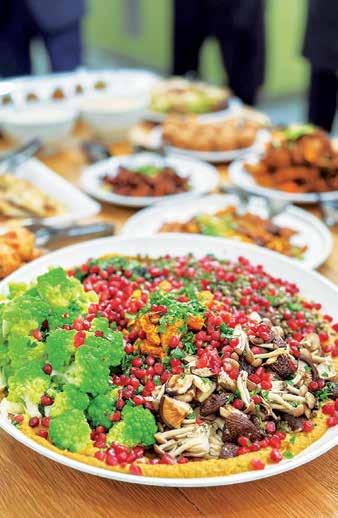
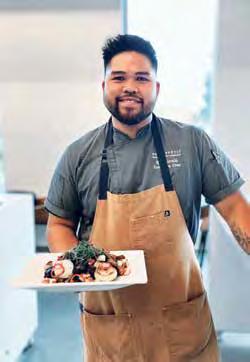
BLEND: “I could go on for days about blending,” says Chris Lenza. “From adding color and flavors, to introducing plant-forward ideas to folks who just want a meatloaf with beef, blending is your segue.”
At Furman University in Greenville, SC, Executive Chef Gustavo Sanchez Salazar keeps a focus on an 80/20 vegetable-to-meat balance in many of his dishes. “I don’t want to force my students to eat vegetables only,” he says. His fritters and croquettes are one part meat and three parts grains (like quinoa) and minced vegetables. “Blending makes your average fritter or hush puppy taste a little different, and we add vegetables that maybe the students haven’t tasted before,” he says.
PICKLE: “Pickling is one of my favorite techniques,” says Matthew Jones, general manager at Birmingham Protective Life in Alabama. “I like to steam or blanch vegetables, then shock them in a cold pickling liquid,” he says. Carrots, radishes, ramps, asparagus, red onion, and mushrooms all transform beautifully into pickles, he adds. “People are like, ‘I’ve never had a pickled mushroom,’ but when they taste them — oh, man. They’re freaking amazing.”
BRINE: At Edwards Life Sciences in Irvine, CA, Senior Executive Chef Jon Sodini dunks whole heads of cauliflower in a brine accented with bay leaves and oranges. These flavors permeate the brassicas, and the brine helps it hold its shape better when slicing into steaks and searing.
CURE AND COMPRESS: During the plant-forward trainings, teams competed in the “Battle of the Bacon” to see who could make the best plant-based bacon. Many cures occurred! A light cure and a few minutes in the smoker, followed by some time pressed under a weight transformed carrots, eggplant, sweet potato, squash, and other vegetables into sides that could stand up to the most delightfully chewy, crispy, salty-sweet pork bacon.
MARINATE: Most chefs think nothing of giving skirt steak or chicken a bath in an herbflecked, garlicky marinade. But vegetables? Most definitely, says Chris Lenza. “Taking the time to develop a robust, umami-forward marinade, and using that with your red potatoes, for example — it’s going to create excitement,” he says. “It’s going to sit with someone and make them think about that roasted potato in a different way.”
Once the seeds of a movement are planted, they need to grow — and spread. For our culinary leaders, this means inspiring their staff to dig into the world of plant-based cooking. “It’s a huge opportunity for chefs to get creative,” says Terri Brownlee. “The world of plants is so broad and deep and rich that really, the possibilities are endless.”
Chefs and managers work to bring that sense of excitement and possibility back to their kitchens — and often, it’s reflected at them by staff whose cultural or dietary backgrounds make them familiar with plant-forward cooking, or by those who are naturally curious and experimental. Other times, it takes consistent effort in training and education to keep teams on point. Here are some of our chefs’ tips for training and empowering their teams to take on plant-forward cuisine.

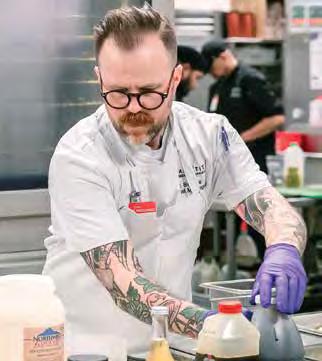
TELL THE STORY: Bon Appétit’s sustainability and wellness missions have been attracting team members to the company for almost 40 years. For many leaders in the field, telling our story has been a simple way to motivate and inspire staff. “I have a lot of fun with the story of what we do and how important it is. It’s helped people care and feel part of the big picture, that there’s more to it than just cooking food,” says Kimberly Triplett, culinary director, Gallaudet University, Washington, DC.
EMPOWER YOUR STAFF: “Not everyone can step into the walk-in and do an episode of ‘Chopped,’” says Joe Dougherty from the University of Portland. “But we have a cool thing going on that’s collaborative,” he says. “I involve my chefs in the menu making process,” he says. “I empower them to try — and if you can get them into it, you know the food is going to be good.”
“I like to brew the Kool-Aid,” says Jon Sodini at Edwards Life Sciences. “I explain the process and do a lot of talking, overtalking, training, teaching, and tasting alongside the cooks,” he says. “When it’s working and people are doing well, I give a lot of praise.”
TAP THEIR EXPERTISE: “I’m super into eggplant right now,” says Paul Rosquita, executive chef at the Gates Foundation in Seattle. “And a big part of that was talking to Mohammed, my steward, who’s Egyptian and has tons of ideas for different things to do with it.” Rosquita’s staff from The Republic of Congo and Mexico have also shared ideas from their cultures. Managers also recommend strategic hiring. “One of our cooks is vegetarian/vegan. She works with the chef on things she likes to cook, and it works out great,” says Matthew Jones at Birmingham Protective Life.
SET EXPECTATIONS: For Carrie Pearl, a district manager in Northern California, it’s important to push teams to accept the challenge of creating dishes that are not only plant-forward, but allergen-friendly as well. “I’m often met with, ‘I don’t know how to do that,’ or ‘I’ve never done that before,’ and I don’t accept it,” she says.
“I think it’s important to have that collaborative process, and not really allow yourself or the people you work with to say something’s not possible.” Collectively, she says, “Bon Appétit is a creative bunch — when we support each other, we can do anything,” says Carrie. “But we can’t do it if you automatically think it’s not possible.”
As we continue to spread the plant-forward love, teams are getting feedback, tweaking their approach based on what they’re hearing, and eventually getting more people excited about eating their vegetables. It’s not always a slam-dunk, as food choices are personal, people know what they like, and some are devoted to their daily meat-and-three.
A growing chorus of diners, especially at education accounts, is asking for more vegan and vegetarian options. Other guests need to taste it to believe it. “I love changing people’s minds about food,” says Jon Sodini, explaining how he slices okra in half vertically and roasts it on high heat to get it crispy, turning okra’s slippery reputation on its head.
Here are some tips our chefs shared for turning their guests on to a plant-forward way of eating.

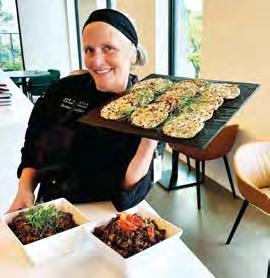
IT: “If you call it vegan, they will not touch it,” says Suzanne Scalfaro, chef-manager at CBRE-Siemens (pictured, above). She gets creative with menu description for the “meat and potatoes people” at her account. Alongside her enormous salad bar stuffed with local produce of all kinds, Suzanne emphasizes salmon and chicken over beef and pork, “rather than push out the animal proteins altogether.”
LIVE ROYGBIV: At Starbucks in Seattle, SODO Kitchen General Manager Eric Battles focuses on color, texture, and temperature — and finds ways to contrast those elements on every plate. Cooking with color feels particularly impactful at his account, he says. “Anytime the plants on the plate are bright, vibrant, composed in any way — we see more traffic,” he says. “And we get more feedback when the salad bar is particularly bright.”
KEEP IT GUEST-CENTRIC: “College students,” says Joe Dougherty, “are not going to stop eating crispy chicken fingers. We think about how we can make it about them and about Bon Appétit’s mission at the same time.” To that end, he says, they’ll shrink the portion of chicken and add an interesting salad or composed vegetable alongside. One concept that works well at the University of Portland, he says, is a bao bar, where small buns just so happen to fit less meat, with plenty of fun plant-forward fillings to join the fun.
TIMING IS EVERYTHING: Consider timing when launching a new station or program, says Grant Ruesch, executive chef at Colorado Christian University in Lakewood, CO. “Sometimes it’s hard in the middle of the semester to launch new things,” he says. “You don’t want them to feel like you’re taking something away — if they feel that way, they might be hesitant to try something new,” he says. Instead, Grant uses the quieter summer months to brainstorm new plant-forward ideas. He’ll launch those “in the fall, when you have a new class with first years who are all on the meal plan,” he says. “Catch them in the beginning and then that’s all they know.”
TELL THE STORY (AGAIN): “Education is huge,” says Nick Walker, director of operations at Emory University in Atlanta. “You’ve got to get in front of it, tell your story about carbon footprint, about nutrition,” he says. “Being able to communicate with students and faculty and get buy-in so you can push your program is really important,” he says.
FINALLY, SPREAD THE LOVE: “If you love what you do, and you love being creative, plant-forward is the way to go,” says Art Ishman at Case Western.
On that note, if you want in on the trainings, they’re still being offered, so reach out to the Wellness team to get the ball rolling. How can you continue to collaborate and build camaraderie around the plant-forward initiative? Collaboration can happen in lots of ways, says Toby Pace, executive chef at Fuqua School of Business at Duke University in Durham, NC, and Transylvania University in Lexington, KY. He holds regular plant-forward calls within his district for teams to collaborate and inspire one another and “talk about what we can do to increase the plant-forward stamp in our units,” he says.
Hats off to our operators, who are constantly working to bring the plant-forward dream to life in their cafés, with creativity, experimentation, and love. Cheers to you — and to plants!
WHEN IT COMES TO HOLDING DOWN THE CENTER OF THE PLATE, SOME PLANTS STAND OUT. CHEFS SHARE WHAT THEY LOVE ABOUT THEIR FAVORITE PLANT-FORWARD PLAYERS.
A wide category, sure, but some of its members are underrated. “I don’t think we’ve tapped the turnip enough,” says Nick Walker from Emory University. Over at the Fuqua School of Business, celery root is Toby Pace’s top pick. “When it’s roasted and caramelized it takes on a steak-like texture,” says Toby. “It’s kind of hefty and meaty.”
“I love eggplant — caramelizing, smoking, roasting — all these techniques bring out all kinds of complexity of flavor,” in the versatile veg, says Joseph Dougherty at the University of Portland.
“They’re one of the most important ingredients in our kitchen,” says Jon Sodini at Edwards Life Sciences. “So versatile, but the liquid, too. I’m a huge fan of making dressings and sauces with aquafaba.”
“Always mushrooms,” says Javier Hernandez, executive chef at Case Western Reserve University. At CBRE-Siemens, “mushrooms are my top,” says Suzanne Scalfaro. “Maitakes and portobellos both work well to anchor a dish,” she says.
“I have an obsession with anything in the brassica family,” says Devin Barzee, chef manager at MKS Instruments in Beaverton, OR. “You can do so much with kale, mustard greens, broccoli rabe — there’s so much flavor in those greens,” he says. Devin is inspired by the ways cuisines around the globe feature greens front and center. “They’re not just sides,” he says. “They’re dishes that anchor whole cultures.”
FINDING WAYS TO CREATE PLANT-FORWARD VERSIONS OF FAMILIAR FAVES IS A FUN CHALLENGE FOR OUR CHEFS. CHECK OUT WHAT SOME TEAMS ARE COOKING UP — ON THE GRILL OR OTHERWISE.
Ryan Garalde, executive chef at George Fox University in Newberg, OR, developed a vegan version of this popular fast food item using soy curls and a cheese-like sauce with chickpeas, tofu, nutritional yeast, turmeric, and roasted peppers. “I made 10 orders and thought they’d never sell,” he says. “We sold 50 the first week, so we kept making more.”
Most grill stations feature a vegetarian burger with chickpeas or black beans, but at Andrews University in Berrien Springs, MI, where the entire campus is vegetarian, there’s a weekly rotation of legume-based burgers, says General Manager Michelle Michalenko. A recent winner was a zucchini-based burger with feta, she says.
“To influence people who aren’t vegetarian is awesome,” says Matthew Jones at Birmingham Protective Life. Case in point: his General Tso’s Tofu, which many guests thought was chicken. “We go through a ridiculous amount of tofu” when it’s on the menu, he says.
For a plant-forward rival of the most popular fast-food versions of this sando, Jon Sodini at Edwards Life Sciences brines wedges of cauliflower and deep-fries them in tempura batter made with chickpea flour. A bean-based sauce and all the typical fixings finish it off.


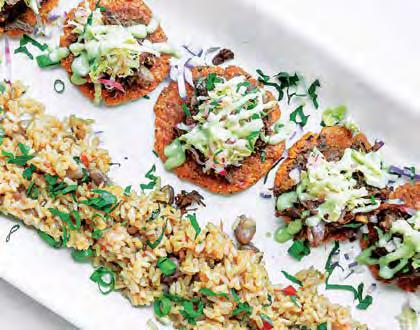
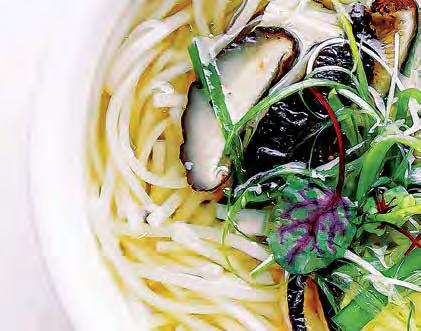
CLOCKWISE FROM TOP LEFT
JACKFRUIT CARNITAS WITH COCONUT ‘CHEESE’ SAUCE, NORTHWEST PLANTFORWARD TRAINING
NOODLES IN BROTH WITH TOFU AND SHIITAKE, NORTHWEST PLANTFORWARD TRAINING
SOUTHERN-STYLE JACKFRUIT “CRAB”
CAKES WITH SILKEN TOFU REMOULADE, NORTHWEST PLANT-FORWARD TRAINING
SMASHED CHICKPEA FOCACCIA WITH KALE PESTO, PEPITAS, AND GRILLED ARTICHOKE HEARTS, WHITMAN COLLEGE
BREAKFAST GRIT BOWL WITH HOUSEMADE SWEET POTATO-IMPOSSIBLE
CHORIZO, OAT MILK STEWED SILKEN TOFU AND PINTO BEAN SAUCE, CRISPY TORTILLAS, AND AVOCADO, NORTHWEST PLANT-FORWARD TRAINING
IMPOSSIBLE LARB STUFFED KABOCHA
SQUASH SERVED WITH A THAI-INSPIRED HOLY TRINITY TOFU SAUCE, NORTHWEST PLANT-FORWARD TRAINING
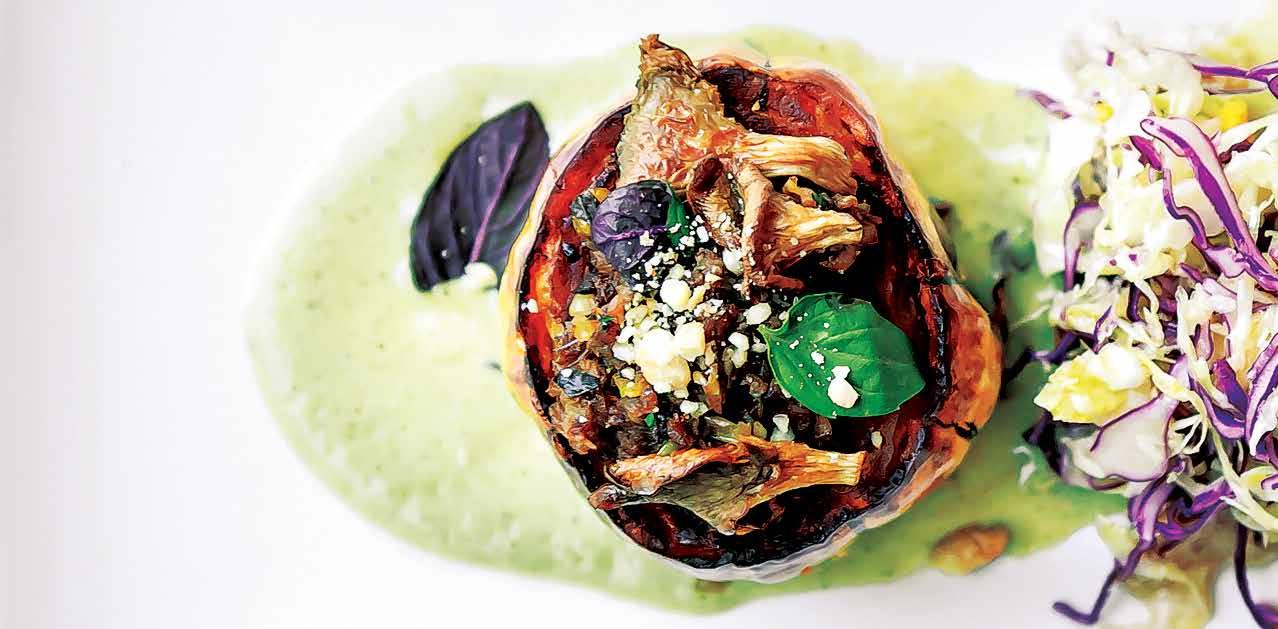

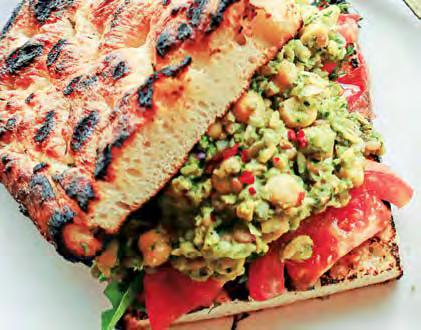


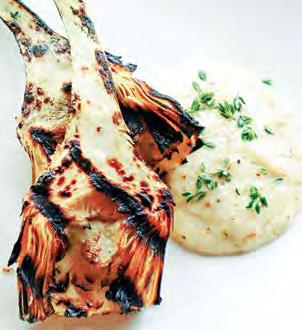
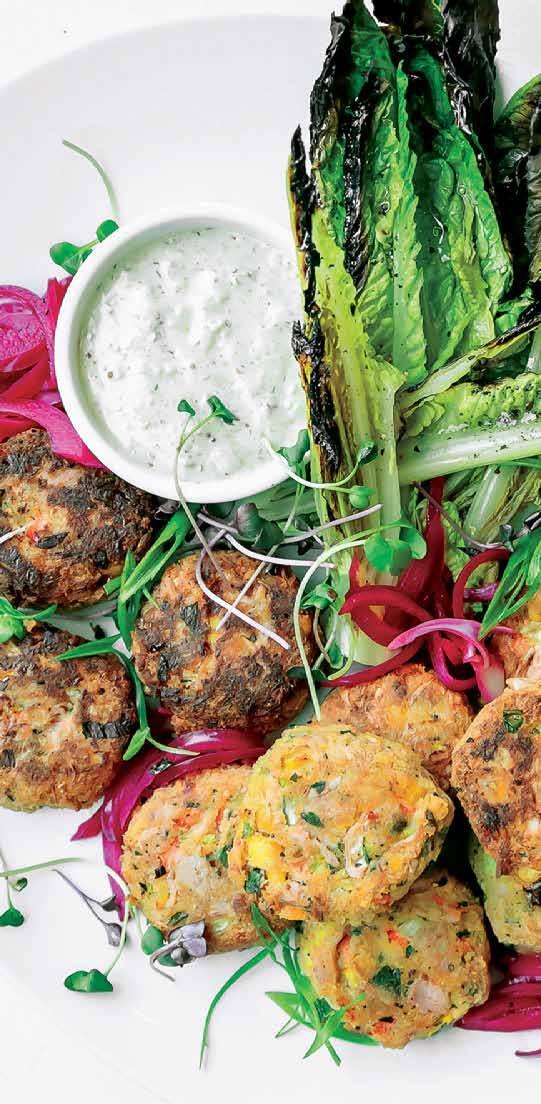
BY LEIGH BELANGER
Mushrooms, it’s been said, are having a moment — a prolonged one. Our current collective interest in ‘shrooms can be found across cultural categories — from art, film, and wellness (adaptogenic mushroom coffee, anyone?) to the culinary world, of course. At Bon Appétit, our culinarians have a fondness for fungi rooted in function, aesthetic, and flavor. Mushrooms, how do we love thee? Let us count the ways.
They spark our creativity: Often dramatic, never conformist, the range of ruffly, spongy, speckled fungi specimens can’t help but capture our imagination. “I am a fan of the textures, the flavors, the looks,” says Javier Hernandez, executive chef at Case Western Reserve University. With morels and chanterelles especially, he’ll pickle or preserve them in oil. “I like to keep them intact to see the look and texture of the whole mushroom,” he says.
They’re plant-forward superstars: Satisfying and versatile, mushrooms are scooting to the center of the plate in all kinds of ways. Chefs throughout the company blend ‘shrooms into ground beef for burgers with less beef (and carbon emissions by extension) but just as much umami. Javier from Case Western suggests blanching and shredding lion’s mane and using it “like crab meat.” At Savannah College of Art & Design (SCAD) in Georgia, Executive Sous Chef Jessica Van Houten stuffs buttermilk-fried oyster mushrooms into a po’ boy for a vegetarian version of a beloved Southern sandwich.
They’re endlessly versatile: Let’s run through a list that demonstrates mushrooms’ culinary range, shall we?
Ony Tirado, culinary supervisor at the Terrace Café at NBC Universal in Burbank, CA, makes a scoby using chaga, reishi, turkey tail, and lion’s mane mushrooms — for future vinegars and kombuchas.
At a tech company in Mountain View, CA, Chef Jimmy Trinh makes a pickled soy shiitake mushroom spring roll with hoisin and sambal olek.
At the same company, Executive Catering Chef Cristina Espinosa’s mushroom “faux gras” (mushroom pâté) is so popular, leadership has asked for the recipe.
Tempura king mushroom bao buns from Executive Chef James Moody were on the menu for Lewis and Clark College’s mycology club meeting recently — Chef James marinates the mushrooms in soy sauce, mirin, and sake before dredging and deep frying them.
Toby Pace, Executive Chef at Duke’s Fuqua School of Business, shreds oyster mushrooms to make carnitas for arepas.
They’re Farm to Fork friendly: As of this writing, we have 45 enrolled mushroom vendors scattered across the country cultivating varieties like oyster, shiitake, lion’s mane, pioppino, enoki, and others.
At the Underground Forest, a F2F partner with University of Alabama Athletics in Tuscaloosa, grower Martin Blair cultivates an array of mushrooms using regenerative and permaculture farming practices. Executive chef Joel Frederick has featured their oyster mushrooms in a collard green wrap with cheese, and plant-based sausage. In Savannah, GA, Fun Guy Mushrooms found a partner in SCAD, says founder Matthew Foreman. “The chefs at SCAD do a wonderful job at creating masterpieces with our mushrooms for students across campus to enjoy,” he says.
Midwest Forager Brian Annapolen met Holly Scott from Fun-gal Farms (yes, we have both a Fun Guy and a Fun Gal among our mushroom vendors, lol) in 2021 and asked if she was interested in growing for Bon Appétit, and how much she would need to sell to us for it to make sense. “We settled on somewhere between 40 to 60 pounds per month at first,” says Brian. “Now we average 60 pounds each week. We really love using them as they are so beautiful, sustainable, and delicious,” he says. Sounds about right — we can see why mushrooms are playing starring roles in our cafés and beyond!

BY TERRI BROWNLEE, VP FOOD EDUCATION & WELLNESS
Has wellness become a loaded word? To answer this, let’s take a walk through time to examine the evolution of the (relatively) new science of human nutrition.
The concept of wellness emerged in the 1980s, focused on educating the public on eating to prevent disease. The result? The battle of good/bad foods began, and the public was beat up with guilt-inducing dietary rules of what (and what not) to do. Paired with the rise in chronic disease and obesity, so also began the blame game. Good health was framed as personal responsibility (read: poor health is due to personal laziness), critics blamed the food industry (super-sizes, processed foods, and all), and we all looked for an explanation.
Then entered the numbers game, with an overreliance on data and details framed as the only path to positive health outcomes. This left many consumers with the impression that no food choices could be made without an entire panel of nutrition facts. Take all of this and layer on the recent movement that’s made wellness more aspirational, and ultimately, wellness feels less accessible to all.
We must stop and ask: Where has it gotten us?
Some would say we’re worse off than when we started — that “wellness” has become a loaded concept, full of confusing messages; that it’s become exclusive and unattainable, wielding an endless cycle of judgment, shame, and guilt; that it labels some culturally significant foods as “bad” without recognizing the role they play in people’s cultures; that the idea of wellness provides a shield for disordered eating.
And we agree — many people have lost trust in their own ability to make decisions about what foods and eating patterns are best for them.
That vision is not the vision of wellness we support at Bon Appétit!
We’re here to challenge this model — often referred to as diet culture — in how we talk about wellness and execute our wellness initiatives. We want to engage with guests in more meaningful and impactful ways that leave them inspired and empowered in their personal wellness journey.
We believe that everyone deserves equitable access to foods that nourish their personal needs, and part of Bon Appétit’s Dream is to make sure that those foods also nourish the communities and the Earth that we all share.
So, what does this mean?
We’re shifting the way we approach our wellness programming and education. This will touch all aspects of our resources — internal, as well as client- and guest-facing. This is a large and complex project for our company and will take time!
In a nutshell — we’re shifting to a gentler wellness approach.
We’ll take a critical eye to all wellness resources to:
• Release diet-culture thinking and messaging
• Promote messages that empower people to make their own personal choices and intentionally and thoughtfully avoid messages that may trigger guilt or shame around food
We’re revamping our programming to engage with guests through:
• Immersive learning experiences
• Opportunities to enhance food literacy
• A focus on culinary nutrition, where we fuse our culinary expertise with our nutritional know-how
We’ll lean in on data where and when it matters most by continuing to enhance how we communicate around food allergies. We’ve already started working quietly on this journey and you’ll hear more about how we’re shifting in the coming months. We’re eager to roll out these changes in partnership with all of you in the field!
BY LEIGH BELANGER
In July 2019, a member of the culinary team at the Cleveland Museum of Art sustained an injury at work. That person’s well-being was impacted, which hurt morale across the board. The team moved quickly to cover scheduling and staffing, and the next day, they started anew on Day Zero, with a refreshed sense of purpose around keeping teams safe at work. As of this past April, they’re celebrating over four-and-a-half years safe.
Many teams with robust safety records cite this sense of purpose as critical to their success. Here are some key insights from leaders to enhance your own efforts in keeping our people safe.
“Regardless of position or tenure, everyone owns a piece of the safety puzzle,” says Susan Davis, general manager at Best Buy in Minneapolis, MN. Different staff members teach different aspects of the safety program. “As you teach, you see things in a different way. That’s probably the greatest factor for our status,” she says. “As you teach, you’ll know the material better — you’ll own it,” Mark Daniels, director of integrated safety, adds. “When your lowest level associate has the expertise, that’s a good indicator of a successful program.”
“Everyone, from dishwasher or receiver to cooks and catering attendants, baristas, all need to feel like they can speak up and bring things forward up the chain,” says Marc Marelich, regional manager in the Northwest. Creating a space where everyone feels comfortable doing that, he says, “takes a lot of thoughtful conversation, one-on-one conversations, and providing opportunities for employees to speak up and speak to each other.”
Safety begins with mindfulness,” says Susan. A poster in the breakroom at Best Buy reminds teams why safety is important. “We have people bring in pictures of their kids, their dogs, their boats,” she says. “We connect the safety program to the things they care about.”
Be Consistent
In the Seattle and Rockies region, RVP Michael Aquaro says an emphasis on making safety the number one priority of every manager’s job from the very beginning (including during the hiring process) and maintaining
that focus day in and day out has been an important factor in his region’s excellent safety record. “I’m super fortunate to have a stellar team who are the ones achieving these milestones,” says Michael. Their consistency has included regional safety calls, every Monday, for over a decade. “We never miss a Monday,” he says.
Apply Emotional Intelligence
“Being in tune where people are at emotionally — it’s been key to our success here,” says Mary Jo Arthur, general manager at Wabash College in Crawfordsville, IN. “We’re a pretty tight-knit group with a caring culture,” she says. If someone’s having a bad day, “we’ll keep them away from hot objects and sharp knives,” she says.
Leaders should build in time to do daily check-ins with staff to get a sense of how people are doing. “Knowing where team members are at and being able to manage in the moment, not just react can really avoid exacerbating certain situations,” says Michael.
“We can be quick to correct, but not as quick to celebrate,” says Mark Daniels. Lifting up teams for safety wins both big and small is an important part of building morale along with that sense of shared ownership, he says. Marc Marelich agrees. His favorite way of handing out praise? “Call out employees in front of everyone,” he says. “10@10’s are great for that but it’s super-powerful outside of the 10@10. Do it in the middle of the kitchen, or during service,” he says.
At the Cleveland Museum of Art, every 10@10 meeting “concludes with positive feedback, encouragement, and anticipation for achieving our next safety milestone,” says Daneene Young, director of operations. And when teams hit big milestones or are on a long-standing streak, that should be “a big celebratory moment,” says Michael Aquaro.

Oh, about that They’ve been injury-free through:
Over 363,000 transactions in the café
49,617 covers in the restaurant
1,231 catered events
More than 5,200 trips to the dumpster and recycling bin
Approximately 13,840 deliveries to the loading dock
“What began as a challenging lesson has provided us with an invaluable opportunity to cultivate a stronger safety culture within our organization,” says Daneene.
In the end, says Mark Daniels, safety isn’t just a list of dos and don’ts. It’s a focus on people. “If we train and equip our teams with the right equipment and know-how, the IFRs will fix themselves,” he says. “If we focus on the people first, everything else will fall in line.” team at the
IF you haven’t downloaded the Nudge app yet, what are you waiting for? It’s a super-fun and informal way to connect with your coworkers. At SODO Kitchen at Starbucks in Seattle, the team gets into the social spirit with playful competitions.
Nudge lets us brag about our coworkers in front of a wider audience, says Kristin White, activation manager. “Teams are making social media interactions based on real relationships among people,” she says. And sometimes, she says “our biggest success on the app comes from being (lovingly) trolled by our work besties.”
From posting a photo of your favorite burger, to giving shoutouts to your café’s bookkeeper or your new sous chef, Nudge is a fun way to spread the love and learn more about your colleagues — not just the ones in your own café. You never know what you might have in common with a fellow Bon Appétiter on the opposite coast! Check out these cookbook “shelfies” that team members shared in a recent Spark session. And download the app so you can start lovingly trolling your work besties, too.
P.S. A note from the Employee Experiences team: We’re excited to share our new orientation program! We make orientation a fun and engaging event, ensuring all team members have a seat at the proverbial (and literal) table. A positive orientation experience charts a course for new associates and helps them envision a future with Bon Appétit.
Let us make the magic happen for you by reaching out to the Employee Experiences team to reserve a spot on our calendar! For more information, contact: Paula Nielsen: paula.nielsen@cafebonappetit.com or Gloria Rios: gloria.rios@cafebonappetit.com
1: AMANDA DEWITT | DISTRICT MANAGER, SOUTHEAST/MIDWEST REGION
2: BRUCE CALVERT| ASSISTANT DIRECTOR OF OPERATIONS| UNIVERSITY OF PENNSYLVANIA
3: ASHLEY GROCE | BRAND ACTIVATION MANAGER, SOUTHEAST | IMAGE + STYLE TEAM
4: BRENNA FRISBIE | CATERING MANAGER | WHITMAN COLLEGE
5: JEN MCGANN | REGIONAL DIRECTOR OF ACTIVATION, SOUTHEAST/MIDWEST | IMAGE + STYLE TEAM
6: WILLIAM TSANG | CATERING ATTENDANT | FRED HUTCHINSON CANCER CENTER
7: ERIC FOSTER | DISTRICT MANAGER, ROCKY MOUNTAINS
8: SAMANTHA REYES | MULTI-UNIT GENERAL MANAGER | PALO ALTO NETWORKS AND JFROG
9: SARAH GOFF | WELLNESS MANAGER | UNIVERSITY OF PENNSYLVANIA
10: RUBEN VILLANUEVA | PRODUCTION CHEF MANAGER | UNIVERSITY OF PENNSYLVANIA
11: JUSTIN RAY | CATERING ATTENDANT | SAND HILL KITCHEN
12: BETH ROBERTSON | ACCOUNTANT | FURMAN UNIVERSITY

4

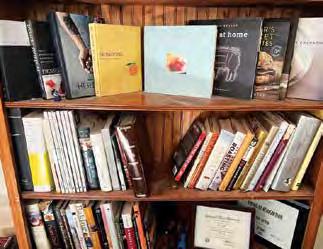
7 11









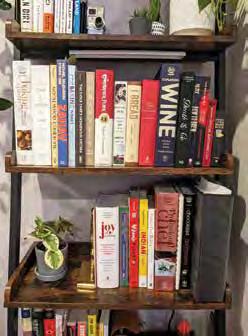

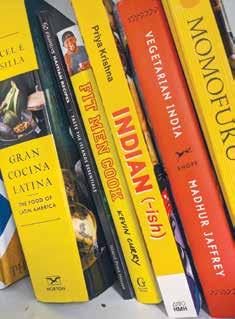
BY WILLIAM PERSSON
You don’t need to be Taylor Swift to get good engagement on social media. It may take you more than a fortnight to meet your social media goals, but consistently posting quality, diverse content will help you leave the endless February of low engagement. Check out these three recent posts from Bon Appétit accounts who are getting that sweet, sweet engagement — and learn what makes them stand out!
Smiling faces always perform well!
Calls to action are a great way to drive clicks to cafebonappetit.com

Bring a solid mix of video, photos, and designed content, including info about guests and employees.
The caption is short, sweet, and explanatory, which is important for a Reels video to perform well
Add relevant or trending music to your post
Give followers a peek behind the scenes — and make it a video to really drive engagement.
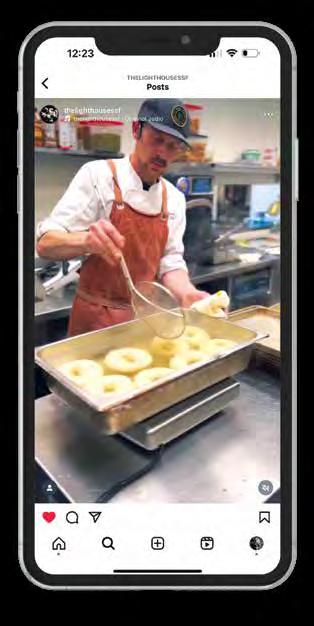
Highlighting our employees always performs well
Don’t fear a long caption! Sometimes you need more space to tell an interesting story.
People are always interested in how things are made!
The audio isandupbeat fun
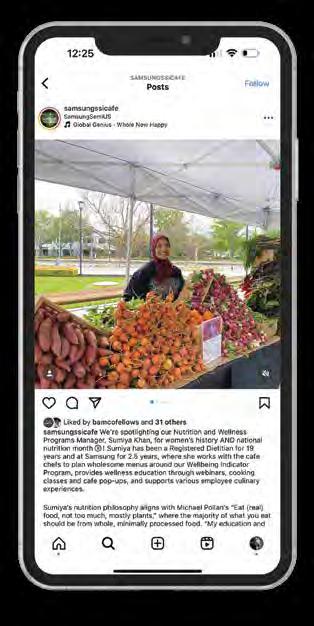
When sharing designed content from the Social Media Cheat Sheet, add some custom images for a healthy mix.


Hot and What’s Not in Bon Appétit’s
STYLE – you know it when you see it. In my role heading up the Image + Style team, I’m constantly looking for inspiration and trying to interpret the trends I track in merchandising and marketing to fit within our company’s own unique style. Here’s what I’ve been noticing lately...
HOT (…in merchandizing generally)
INGREDIENTS:
Local and seasonal foods attract folks seeking quality and traceability.
PRODUCTION METHODS:
Artisanal and handcrafted items bring the authentic, premium vibes.
NOURISHING:
Wholesome items like fresh produce and whole grains speak to the health-conscious guests among us.
CONTEXT:
Everyone loves a good story, so put the origin stories, producer profiles, and sustainability goals front and center. Engage guests and build trust and loyalty.
WHAT’S NOT: We are so not into
•Props that have no actual function
•Fake flowers over real ones
•Highly processed foods
•Greenwashing
•Lack of context. Tell us a story!
specifically)
ERA: the 1990s is iconic GenX decade ushered in a blending of traditional and modern elements. ink fusion food, but for interior design.
WALLS: texture + bold colors + patterns
Let’s move on from neutral and minimalist…embrace the bold!
SURFACES: cork + terracotta + ceramic
Natural materials can evoke warm, comfy vibes and a connection to the environment.
TABLETOP: bespoke + whimsical + nostalgic
One size fits all is so last decade. Let the table reflect your individual style! Create a fun and relaxed atmosphere with delightfully personal elements.
FURNITURE: squishy + curvy + soft
Curves and soft materials invite you in and soften the look of your space.
FINISHES: gold + brass + copper
Mix your metals for a sleek, sophisticated, and innovative look.
WHAT’S NOT: Please let’s move away from
•Grey on grey on grey (i.e. neutral and “safe” colors and patterns)
•Letting the algorithm make our design choices
•All right angles all the time
•Matchy-matchy everything
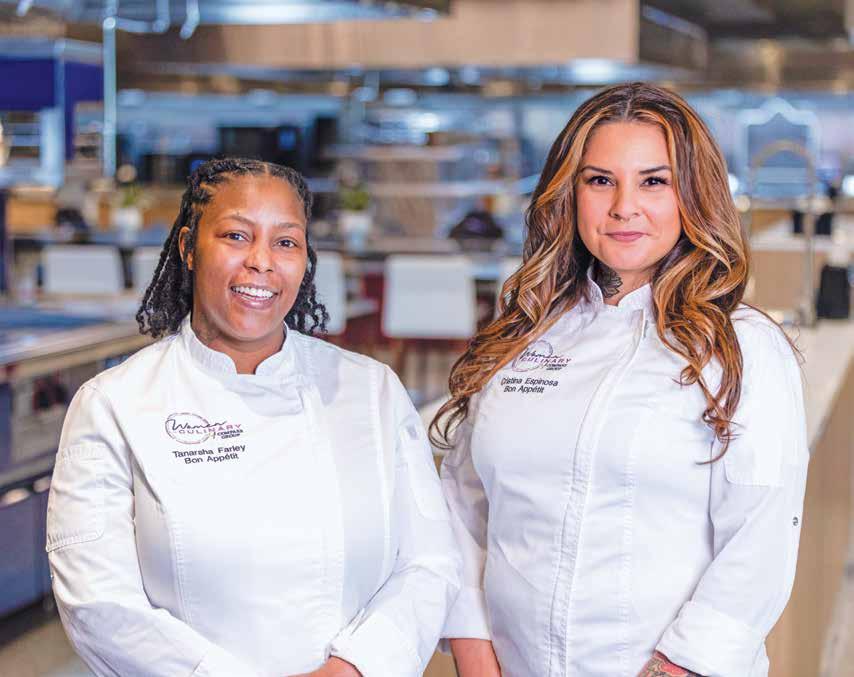
I’m soaking up everything that I can learn and trying to be better than I was yesterday.
Tanarsha Farley (L), executive sous chef at Emory University, and Cristina Espinosa, an executive catering chef at one of our Bay Area technology accounts, were chosen this year to represent Bon Appétit at Compass Group’s annual Women in Culinary Showcase. We are lucky to have these two amazing women culinarians! Read more of their story by scanning the QR code.

I really just want to push the envelope when it comes to women in the industry.
– Tanarsha – Cristina